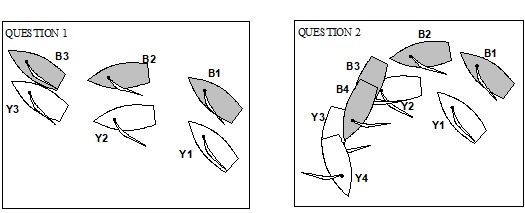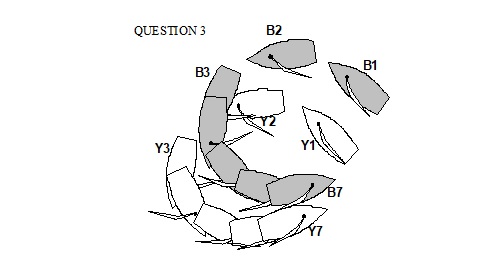


Section D - The Windward Leg
TR CALL D1
Rule 10, On Opposite Tacks
Rule 11, On the Same Tack, Overlapped
Rule 15, Acquiring Right of Way
Rule 16.1, Changing Course
Definitions, Keep Clear
Question 1
Y and B are beating on starboard tack, overlapped with ¼ boat length between them.
Y bears away to give herself space to tack behind B, but B bears away onto a parallel
course to prevent Y from tacking. Y luffs; B responds promptly, but there is contact.
Y protests. What should the call be?

Answer 1
At position 2 Y is right-of-way boat and B is keeping clear of her. Rule 16.1 requires
Y to give B room to keep clear when she changes course. Y fails to give B room when
she luffs. Penalize Y.
Question 2
Y and B are beating on starboard tack. Y bears away to gybe out, and B also bears
away. At position 3 Y is clear ahead. When Y gybes onto port, B maintains her course
and there is contact. B protests. What should the call be?
Answer 2
Y gives up right of way when she gybes, so B is not subject to rule 15. Y breaks rule
10. Penalize Y.
Question 3
Same situation as Question 2, except that Y is able to gybe and keep clear of B. B
chooses to gybe and then luffs hard to turn inside Y. Because Y (now leeward boat on
port tack) also luffs, there is contact. B protests. What should the call be?

Answer 3
When B gybes, she becomes keep clear boat. Rule 15 does not apply as B gave up right
of way. However, rule 16.1 now applies if Y changes course. By changing course
without giving B room to keep clear, Y breaks rule 16.1. Penalize Y.
If Y were to stop changing course the moment B gybes and there were still contact (or
if Y does change course but there clearly would have been contact even if she had not)
then B breaks rule 11.







